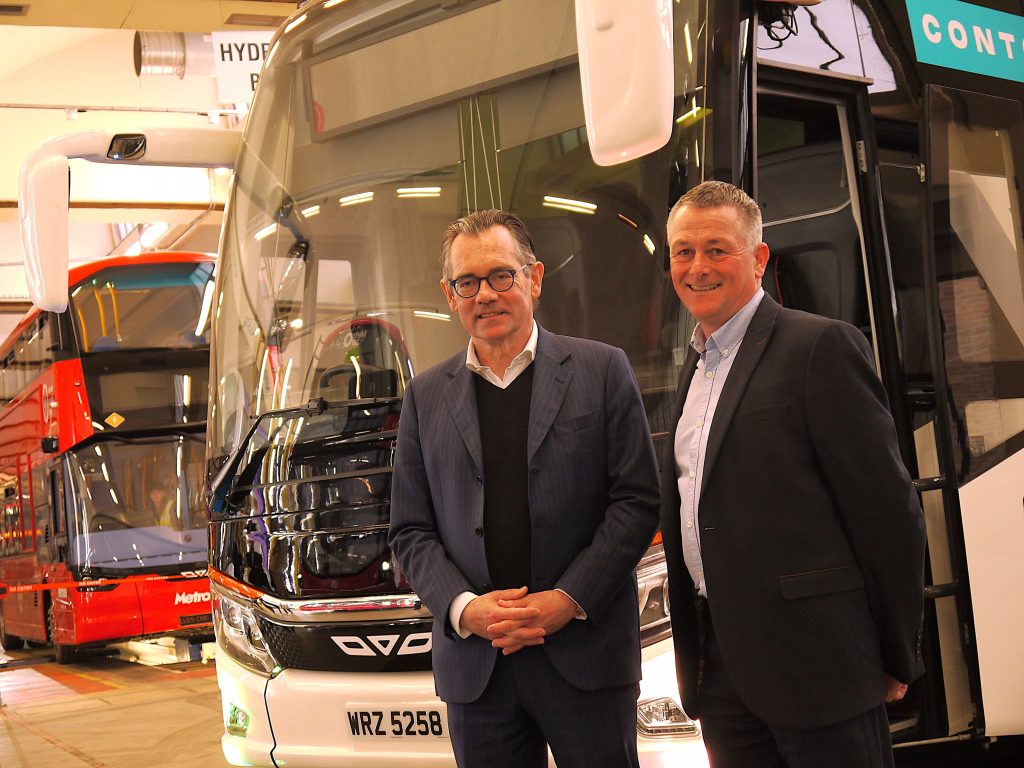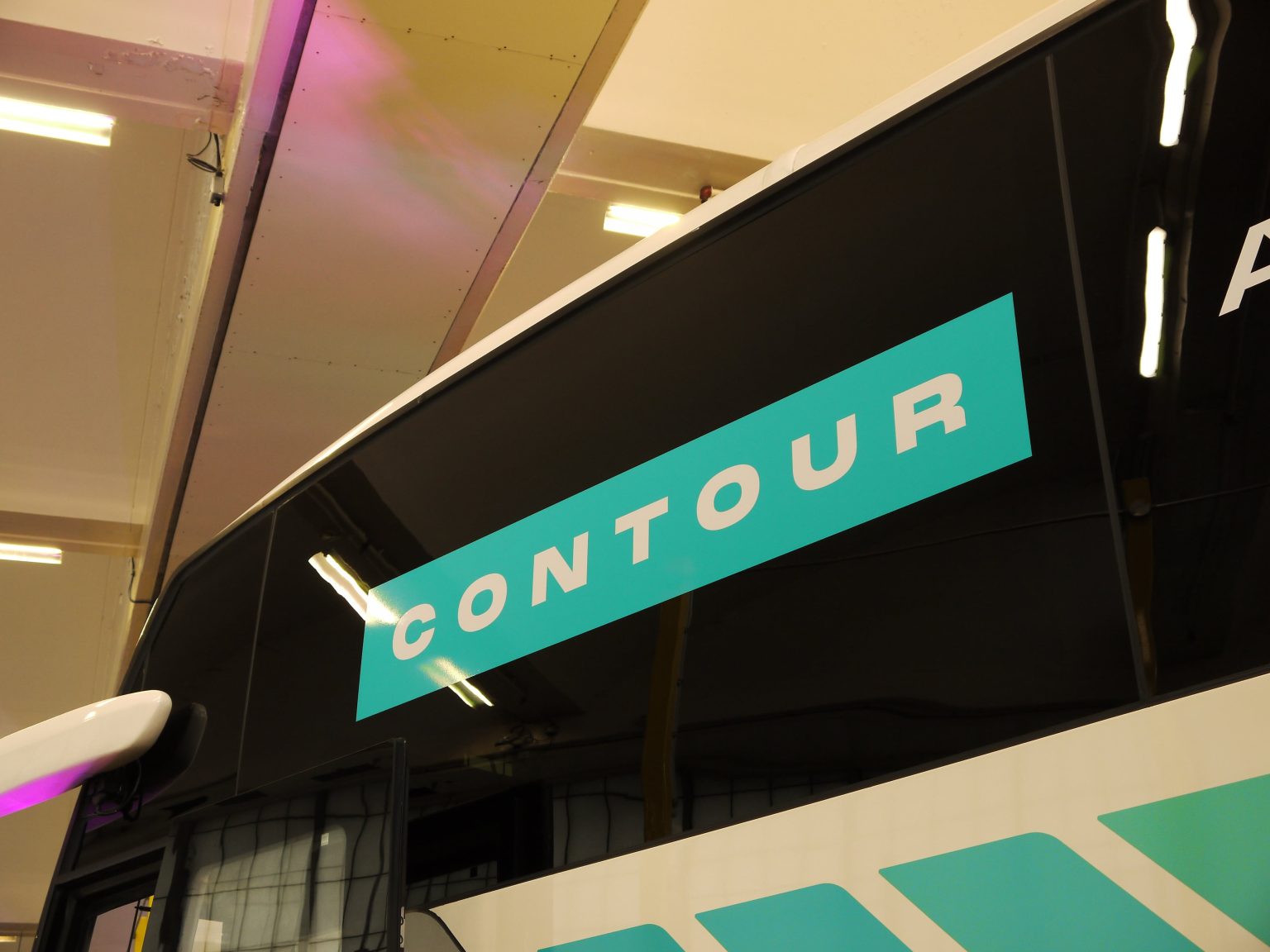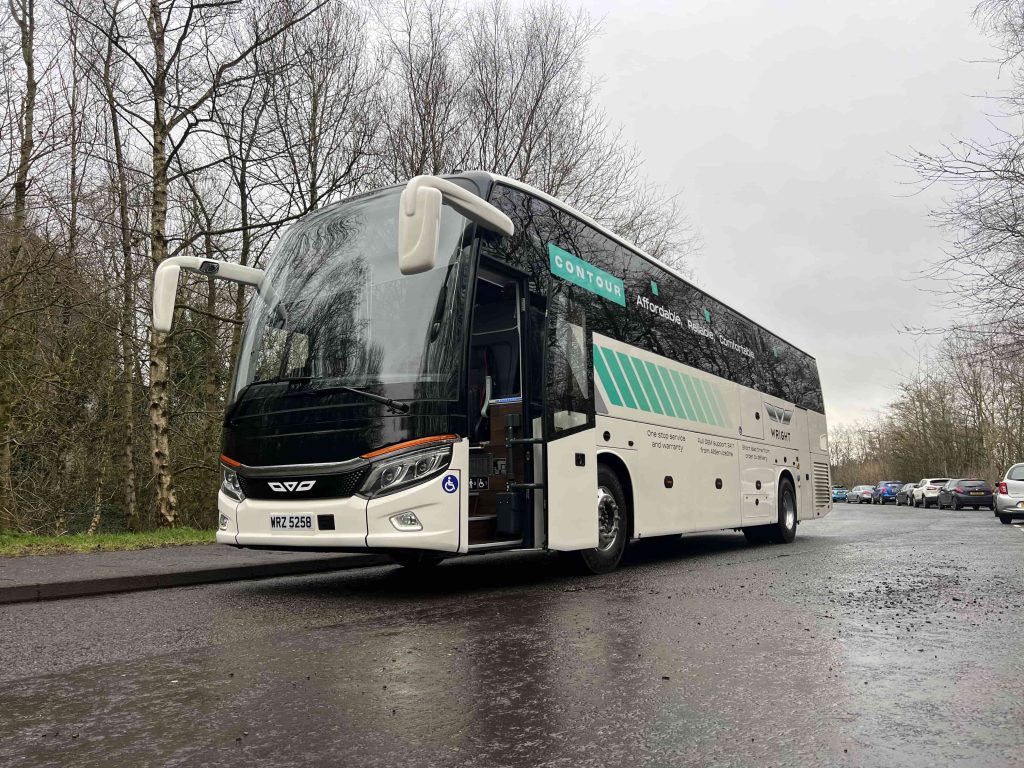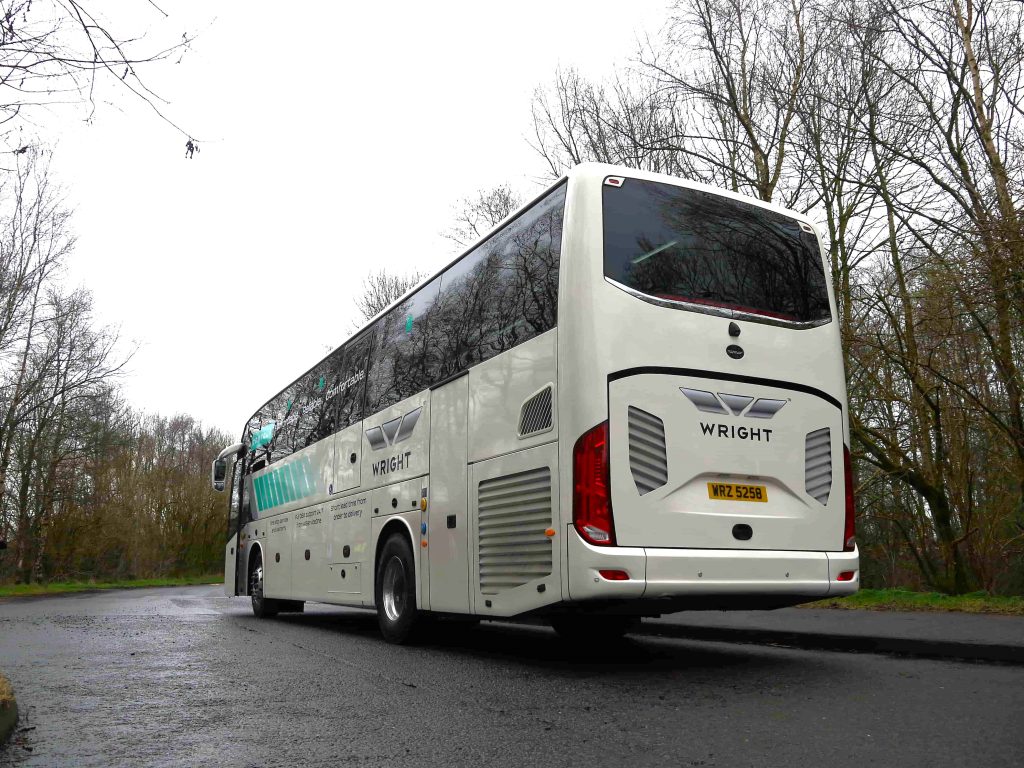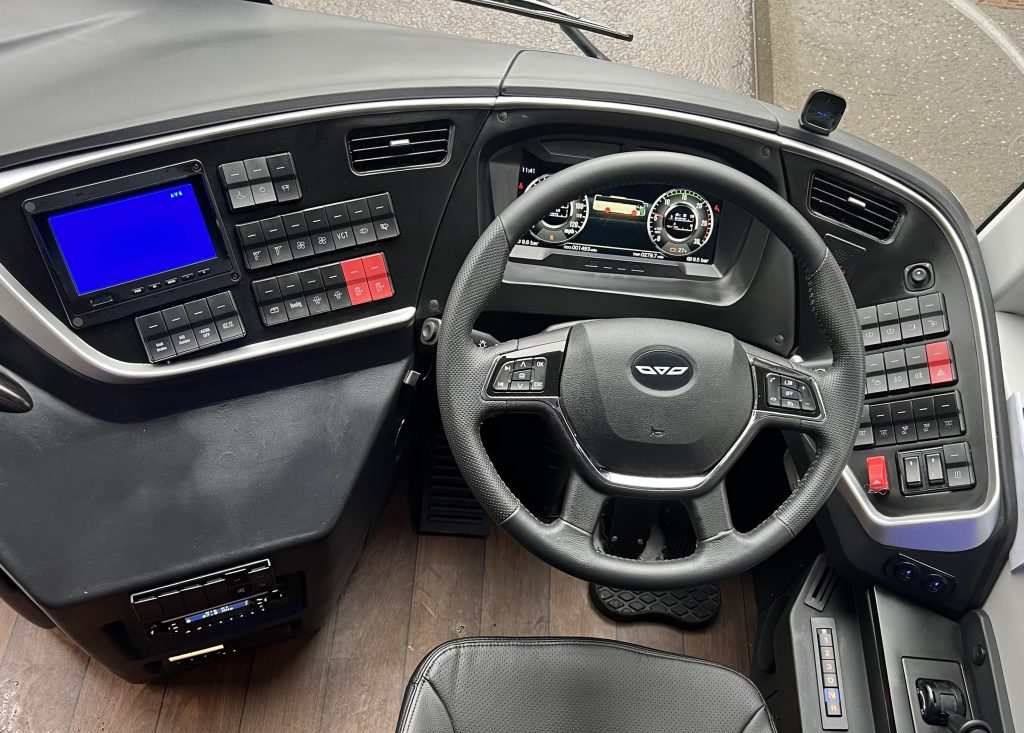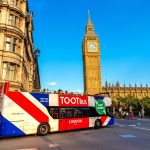Reviving a historic model name on a new vehicle taps into many things buyers enjoy: Nostalgia, brand recognition, and customer loyalty. It’s also more cost effective than trying to market an entirely new one.
Wrightbus is the latest to revive a name from its past with the Contour, last seen circa 1987 on the chassis of a Volvo B10M. The company debuted its new vehicle to a select group of press and customers on 5 March. Manufactured by its partner King Long in China as part of a five-year deal, Wrightbus will conduct pre-delivery inspections before vehicles reach customers.
The original Contour, introduced on a Bedford chassis, was groundbreaking in many respects — pioneering features still seen today such as bonded windows and double glazing. The latest revival will have the legacy of its predecessor to live up to, and from the outset, Wrightbus is positive that the new Contour is set for success.
The new Contour
The new Contour is a 12.2m, 55-seater twin-axle built with a stylish interior that emphasises passenger experience. USBs on every seat and a toilet are fitted as standard.
Power is via the Cummins X11 Euro VI engine, rated at 400bhp.
That is driven through a ZF EcoLife automatic gearbox. A two-year/200,000-mile warranty and a 12-year structural warranty are standard.
A comfortable product with flexible luggage space is a core value from the original days of Wrightbus coaches, and that remit has not changed, according to Dave Porter, Wrightbus Head of Coach Sales. Driver happiness has also been a focus; within the European[1]style wraparound cab area, the digital dash display incorporates the EU’s GSR2 and tyre pressure monitoring, ergonomic switches designed with comfort in mind, and a large refrigerator in the dash.
Three variants will be available, including standard, PSVAR-compliant and PSVAR-prepped options. That will offer protection over second life. Luggage space in the standard variant is nine cubic metres, reduced to seven cubic metres with a passenger lift fitted.
Aftersales backup will be provided through AllServiceOne, Wrightbus’s fleet support business, with its UK and Ireland-wide network of over 70 mobile technicians. According to Managing Director for Aftersales and Telematics at AllServiceOne Jon Eardley, that includes bumper-to-bumper care, and a recognition that the coach sector is distinct from bus.
“We recognise there is no such thing as a spare coach, and that uptime is key for operators,” he says. “These vehicles have a strong engine and axle, strong transmission, and we know these technologies. We are close to ZF and Cummins with full diagnostic capability in our vans and service centres in Ballymena, Bicester and Brühl. We can also tailor repair and maintenance packages for preventative and reactive maintenance by leaning in on our mobile network.”
A new player in the diesel segment
Wrightbus as a manufacturer has made clear its focus on zero-emission (ZE) vehicles. It continually flies the flag for ZE solutions through owner Jo Bamford’s portfolio of companies, while its production output, set to hit 1,200 vehicles in 2025, has gone from 50% ZE in 2022 to 95% ZE in 2024. Its agnostic approach to technology was underscored in January with the launch of a new range of light battery-electric vehicles through King Long; its target is to expedite the transition to cleaner drivelines as efficiently as possible.
It might therefore seem unusual that the company is investing into a brand-new diesel product; but hints of that had been dropped in a conversation between routeone and CEO Jean-Marc Gales back in January. Jean-Marc had suggested then that the Contour name was slated for a revival; and that the company was looking to “bridge the gap” between today and the introduction of its promised hydrogen fuel cell-electric coach in 2026.
According to Dave, who is overseeing both the Contour and Hydroliner coach projects, a diesel coach makes sense because manufacturers are still looking at the potential for Euro 7 — clarity
on which will determine if any other worthwhile products will be forthcoming.
“That is more eminent in Europe,” Dave adds. “Legislation will drive us. But we need to meet Euro 7 for the European deadline in 2027. That’s our task until customers demand otherwise.”
Wrightbus’ solution will also meet the needs of customers in a market that has “immeasurably changed” in recent years. That includes PSVAR, the pandemic, and a lack of stock being held by many present OEMs.
“The coach market is a reactionary market and coach customers, I am sure they won’t mind me saying, are not always fantastic at planning, through no fault of their own,” Dave explains. “Operators don’t often know what will happen day-to-day; they have an outline, but it is a process. And we feel we can help with that.”
That flexibility is being delivered through a promise to be competitively priced and with a lead time of six months. “We’re currently asking operators to guess up to two years in advance to make decisions about vehicles,” Dave says. “That’s impossible. Customers are taking financial risks that are not viable. Within that environment, COVID-19 saw vehicles rise approximately 30% in price. We will work with our customers and give them an offering to alleviate those worries.”
More details on Hydroliner
More details have also been shared on the Hydroliner coach project, intended as a long-distance ZE option in the scheduled and commuter market.
Rob Best, Engineering Director at Wrightbus, spoke publicly about the Hydroliner coach for the first time, revealing the vehicle will be Wrightbus’ first ever fully integral coach product, designed entirely in house. Whether that will also be badged Contour has not been confirmed.
The initial variant will be a 15m tri-axle overdecker capable of accommodating 69 passengers on the upper deck and up to 15 passengers and two wheelchair users on the lower deck.
Luggage space will be a minimum 10 cubic metres, dual-shelved in the rear (akin to a Van Hool TDX21 Altano), as well as in the space forward of the wheel arch. A bulkhead within the luggage space will be movable, allowing customers to accommodate more luggage at the expense of lower-level seating.
A single-deck version Hydroliner is also being considered for later, while Wrightbus says a modular construction will make it suited to a number of different drivetrain options, depending on demand, as well as lower hydrogen capacity if the claimed 1,000km range is not needed.
The chassis will be built in Ballymena, but Wrightbus has not yet confirmed where the body will be made.
Development has been a customer-collaborative process, and Wrightbus has been communicating with three major operators in the scheduled market on the project. According to Wrightbus, the Hydroliner lends itself to those customers; its range will be equivalent to a tank of diesel, coupled with speed of fill.
“Those three customers all had as a minimum requirement a range of 1,000km,” adds Rob. He adds that those customers were mindful of current battery-electric range limitations and want more from hydrogen. “We feel this is a large sector of the market and as hydrogen supply becomes more readily available, more operators will desire a coach that can do 1,000km.”
Left- and right-hand drive variants of both the Hydroliner and the Contour will be available. A left-hand drive Contour is expected to arrive in Ballymena later this year.
Demo period ahead
A UK and Ireland demonstration of the Contour will begin in the coming months and routeone understands the company is keen for the coach to attend this year’s ALBUM conference in May.
Jean-Marc reiterates previous comments that Wrightbus’ move into coaching is a long-term one, and is a reaction to a reduction in market supply. “When we heard there was no coach manufacturing in the UK, we said ‘that can’t be the case’,” he says. “We need to bring coaches back. We brought Dave Porter into our company, and this is not a one-off programme; this is a three-or four-year, long-term strategy to become a main player for the future.”
Commenting specifically on the decision to develop a hydrogen coach product, Jean-Marc adds: “This is our core DNA. We are a vehicle manufacturer. This is our 80th year, and our biggest unique selling point for the last five-10 years.
“We really believe we can put a world-class zero-emission powertrain into this coach at a time when the coach industry is struggling to decarbonise. We feel the timing of this couldn’t be better and we’re looking forward to launching this product properly in 2026.”
If the Hydroliner’s target is to help the scheduled and commuter coach market to decarbonise, then the Contour positions itself as a competitor to brands such as Temsa and Yutong. Those owe much of their success to their support and a good reputation for customer service, and Dave acknowledges that the Contour competes in a similar sector. He caveats that by suggesting that Wrightbus also knows, without being specific, the gaps in the market on which it wants to capitalise.
“We’re open to anybody, is the answer,” he says. “We need to broaden our horizons and spread the word: Wrights is associated with coaching again.”
